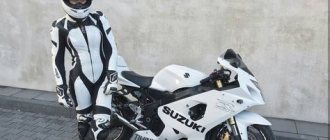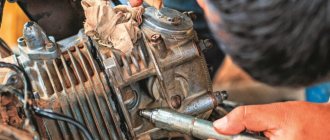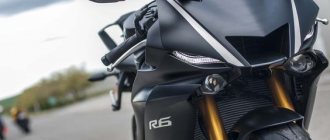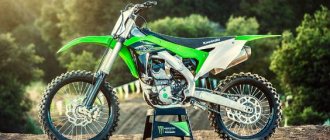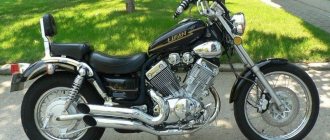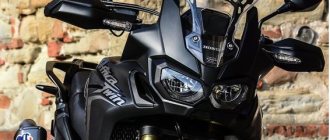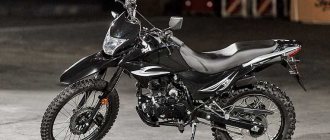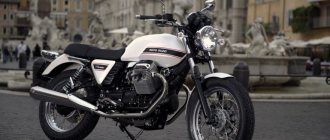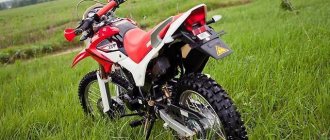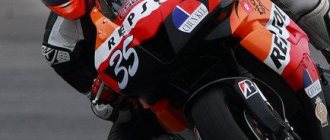The tenacious and durable enduro Suzuki DRZ 400 is well known to those who like to ride off-road on two wheels. This motorcycle has been produced in different versions since 2000 , and many copies of this model travel on Russian roads. In Europe, the bike has not been officially sold for a long time, since it does not comply with strict environmental standards of the European Union, but used copies in Russia and the CIS countries in 99% of cases come directly from Japan. And in its class, DRZ can be called one of the best!
Design
Who said "design"? For harsh enduro, this concept does not exist; the emphasis is not on a pretty appearance, but on reliability, power and the ability to overcome mud in which an Abrams tank can easily get stuck. Japanese designers hired by Suzuki think so, otherwise there is no way to explain why the Suzuki DRZ 400 looks almost indistinguishable from other enduros. And the off-road version differs visually from the SM version (supermoto, that is, motard) only in the wheels. But such motorcycles are loved not for their design, but for what they are capable of.
Technical characteristics of Suzuki DRZ 400
They depend on the modification of the motorcycle. The most powerful was the DR-Z400E, discontinued in 2005 and not intended for use on public roads. But all Suzuki DRZs have decent technical characteristics, and they will not let the owner get bored.
Engine
The single-cylinder liquid-cooled power unit produces 40 horsepower and 39 Nm of torque (48 hp and 41 Nm for the DR-Z400E). It has powerful traction in the upper rev range, and at the same time is capable of pulling out a bike stuck in the mud with one jerk. On the road, the motorcycle is capable of reaching a speed of 150 km/h , but maintaining high speeds for a long time is not recommended - the engine is not designed for this, its element is rough terrain.
Transmission
Japanese engineers decided not to reinvent the wheel, and equipped their brainchild with a classic 5-speed gearbox . The first three gears are very short - what you need for an off-road bike. You have to actively use your left foot, but thanks to this, the DR-Z acquires explosive acceleration dynamics at low speeds.
Chassis and brakes
Different versions of the motorcycle are equipped with the same steel frame , but there are other differences between the enduro and supermoto versions. The first received a classic 49mm Showa fork with a full range of adjustments, and the second received a 47mm first fork , also adjustable, also made by Showa. On a regular Suzuki DRZ, a long-stroke monoshock absorber with progression (a full range of adjustments) is installed at the rear, and on the DRZ400SM there is a similar one, but a little shorter stroke (276mm versus 295mm). Braking is handled by 250mm discs at the front and 220mm at the rear (on enduro; on motard – 300mm at the front and 240mm at the rear). The calipers are the same, 2-piston front and 1-piston rear .
Electronics
There is a minimum of it in this model. Any biker who is not afraid to get his hands dirty can figure out the electrical circuit of the Suzuki DRZ 400. Let us only note that the very first modification of the bike, DR-Z400, discontinued in 2005, was additionally equipped with a kickstarter.
Weight and dimensions
Despite the conventional steel frame instead of a light alloy one, the Japanese managed to create a motorcycle that was light by class standards. Dry weight for the DR-Z400S is only 132 kg , for the DR-Z400E - 119 kg , for the DR-Z400SM - 135 kg . The dimensions accordingly correspond to these parameters:
- 2310 x 875 x 1240 mm (DR-Z400S)
- 2225 x 855 x 1200 mm (DR-Z400E)
- 2310 x 825 x 1235 mm (DR-Z400SM)
Controllability
Due to its modest weight the Suzuki DRZ handles excellently , which is why it is loved by tens of thousands of bikers. Off-road, it feels like a fish in water, and an experienced motorcyclist will have no problems holding it even on slippery and uneven surfaces. But on the highway, the Suzuki DR Z lacks directional stability due to narrow wheels and vulnerability to side winds.
Fuel consumption
It very much depends on the driving style, operating conditions and technical condition of the particular vehicle. If you try to get something in between, then in the city the consumption is unlikely to exceed 4.5-5 liters , and on the highway this figure will drop to 3.5 liters if you maintain a speed around 120 km/h . On the off-road, it is impossible to predict the consumption, but it certainly will not be low. You need to monitor the fuel level, since the gas tank holds 10 liters , of which 2.3 liters are reserve.
Motorcycle Suzuki DR-Z 400 SM 2021 review
The description of the Suzuki DR-Z 400 SM 2021 motorcycle is in the queue for publication of the article. Announcement: Today, for almost every new motorcycle that comes into being, marketers strive to carve out their own niche. This one is a road sport, this one is a recreational enduro. But what class should we include a motorcycle that has a little bit of everything? A good bike should have a reliable engine, comfortable ergonomics and simple controls...
Suzuki DR-Z 400 SM is a motorcycle of average popularity in Russia equipped with a high-power 39.7 hp engine. Despite the fact that good models of motorcycles have a very respectable price, and the season for their use is relatively short, the motorcycle market is developing rapidly. And if you believe the words of dealers, then some models of recently released motorcycles are selling like hot cakes at the beginning of the season, and the models brought to Russia are clearly not enough to fully satisfy consumer demand.
A motorcycle has long ceased to be an alternative to a car, and the times when this equipment was bought only because there was not enough money for a full-fledged car are forgotten. Nowadays, two-wheelers can be called technological marvels in many cases, and their cost can be compared with that of prestigious cars.
Many people have started buying motorcycles for hobby purposes as riding or even collecting them has become a good pastime for many people. Many motorcycles, for example the Suzuki DR-Z 400 SM, whose technical characteristics allow the model to be called a prestigious brand, are in demand among both beginners and experienced motorcyclists.
Motorcycles with an engine capacity of 398 cc / 24.3 cu-in. see, appeared as a result of long work of inventors who sought to create a model that was not inferior in characteristics to other versions of the motorcycle. In some cases, these models are not only not inferior, but also ahead of other motorcycles, as they have minimal fuel consumption and other excellent parameters.
Motorcycles from 250 to 400 kb. see which includes the Suzuki DR-Z 400 SM - this is the most common class of motorcycles. In this range you already have a choice among almost all classes of motorcycles. Many people call this category the most suitable for a first motorcycle. You can purchase a moderately heavy, powerful and flexible motorcycle for relatively little money. Many people advise taking a road bike with a 400 cc engine as your first choice. We cannot completely agree with this, because such motorcycles often weigh about 200 kg and have a sufficient power reserve. If your skills in riding a two-wheeled vehicle are limited to a training motorcycle at a motorcycle school, then you should not immediately take such a device. Many beginners get into ridiculous accidents simply because they do not know all the features of operating such equipment. After all, the heavier and more powerful the motorcycle, the better you should know how to handle it in different situations. Even a monkey can just drive in a straight line (no joke).
Go to the entire model range of Suzuki motorcycles, on this page you can find Suzuki DR-Z 400 SM motorcycles from other years of production and information about them
Motorcycle price
Russian bikers do not often buy new motorcycles, preferring used ones supplied directly from Japan. Suzuki DRZ is not officially sold in Russia, so all copies come to us straight from the Land of the Rising Sun. The cost on the secondary market starts from 120-130 thousand for the oldest Suzuki DRZ, and can reach up to 400 thousand for fresh motorcycles in good technical condition.
The Suzuki DRZ 400 SM is on average more expensive than its off-road counterparts in the model range.
Repair and tuning
Suzuki DRZ is reliable, and all tuning usually comes down to improving its already decent characteristics. There are plenty of offers on the Internet, but they will be of interest mainly to bikers who are well versed in the topic and know how exactly this or that part will be useful to them.
Repair
According to reviews, Suzuki DRZ rarely breaks down. It is distinguished by excellent durability, and even if it falls head over heels, it is unlikely that anything will fall off of it except the mirrors. Other breakdowns are most often caused by untimely maintenance, and they can be avoided if you take proper care of your two-wheeled friend.
Spare parts
Not everything is available, but this problem is familiar to all Russian bikers. You can find absolutely everything to order, from a clutch cable to an entire engine. Prices are comparable to those of 95% of other Japanese motorcycles.
Tuning
Often, owners of Suzuki DRZ equip the bike with protective cages, hand protection, install a lightweight exhaust system, or install other wheels . Sometimes the suspension also changes, but this pleasure is not cheap. There is enough tuning for this model, but the price of individual components can be exorbitant.
Motorcycle modifications
Of the four versions that were produced, there are now two left - the enduro DRZ 400S and the motard DRZ 400 SM. The latter is distinguished by smaller radius wheels, different suspensions and stronger brakes - these differences are described above. But previously two more modifications were produced, the Suzuki DRZ 400 (with kickstarter and without PTS), removed from the production line in 2005, and the DRZ 400E, with an engine retuned for more power, but also not intended for public roads. It was discontinued in 2009.
Brief history of the model
- 2000 - start of production and sales of the series. There are three models available in the market: Suzuki DR-Z400, Suzuki DR-Z400S and Suzuki DR-Z400E.
Model:
Suzuki DR-Z400, Suzuki DR-Z400S, Suzuki DR-Z400E (all markets).
Factory designation:
DR-Z400Y, DR-Z400EY; DR-Z400SY.
2001 - no significant changes.
Model:
Suzuki DR-Z400, Suzuki DR-Z400S, Suzuki DR-Z400E (all markets).
Factory designation:
DR-Z400K1, DR-Z400EK1, DR-Z400SK1.
2002 - no significant changes.
Model:
Suzuki DR-Z400, Suzuki DR-Z400S, Suzuki DR-Z400E (all markets).
Factory designation:
DR-Z400K2, DR-Z400EK2, DR-Z400SK2.
2003 - no significant changes.
Model:
Suzuki DR-Z400, Suzuki DR-Z400S, Suzuki DR-Z400E (all markets).
Factory designation:
DR-Z400K3, DR-Z400EK3, DR-Z400SK3.
2004 - no significant changes.
Model:
Suzuki DR-Z400, Suzuki DR-Z400S, Suzuki DR-Z400E (all markets).
Factory designation:
DR-Z400K4, DR-Z400EK4, DR-Z400SK4.
- 2005 - Suzuki DR-Z400 version is discontinued. The appearance of the Suzuki DR-Z400SM modification.
Model:
Suzuki DR-Z400SM, Suzuki DR-Z400S, Suzuki DR-Z400E (all markets).
Factory designation:
DR-Z400SMK5, DR-Z400SMUK5; DR-Z400SK5, DR-Z400EK5.
- 2006 - no significant changes.
Model:
Suzuki DR-Z400SM, Suzuki DR-Z400S, Suzuki DR-Z400E (all markets).
Factory designation:
DR-Z400SMK6, DR-Z400SMUK6; DR-Z400SK6, DR-Z400EK6.
- 2007 - no significant changes.
Model:
Suzuki DR-Z400SM, Suzuki DR-Z400S, Suzuki DR-Z400E (all markets).
Factory designation:
DR-Z400SMK7, DR-Z400SMUK7; DR-Z400SK7, DR-Z400EK7.
- 2008 - Suzuki DR-Z400E version is not produced.
Model:
Suzuki DR-Z400SM, Suzuki DR-Z400S (all markets).
Factory designation:
DR-Z400SMK8, DR-Z400SK8.
- 2009 is the last year of production of the Suzuki DR-Z400E.
Model:
Suzuki DR-Z400SM, Suzuki DR-Z400S, Suzuki DR-Z400E (all markets).
Factory designation:
DR-Z400SMK9, DR-Z400SK9, DR-Z400EK9.
- 2010 - no significant changes.
Model:
Suzuki DR-Z400SM, Suzuki DR-Z400S (North America, Australia).
Factory designation:
DR-Z400SML0, DR-Z400SL0.
- 2011 - no significant changes.
Model:
Suzuki DR-Z400SM, Suzuki DR-Z400S (North America, Australia).
Factory designation:
DR-Z400SML1, DR-Z400SL1.
- 2012 - no significant changes.
Model:
Suzuki DR-Z400SM, Suzuki DR-Z400S (North America, Australia).
Factory designation:
DR-Z400SML2, DR-Z400SL2.
- 2013 - no significant changes.
Model:
Suzuki DR-Z400SM, Suzuki DR-Z400S (North America, Australia).
Factory designation:
DR-Z400SML3, DR-Z400SL3.
- 2014 - no significant changes.
Model:
Suzuki DR-Z400SM, Suzuki DR-Z400S (North America, Australia).
Factory designation:
DR-Z400SML4, DR-Z400SL4.
- 2015 - no significant changes. Resumption of production of DR-Z400E.
Model:
Suzuki DR-Z400SM;
Suzuki DR-Z400S; Suzuki DR-Z400E (North America, Australia). Factory designation:
DR-Z400SML5; DR-Z400SL5; DR-Z400EL5.
- 2016 - no significant changes.
Model:
Suzuki DR-Z400SM;
Suzuki DR-Z400S; Suzuki DR-Z400E (North America, Australia). Factory designation:
DR-Z400SML6; DR-Z400SL6; DR-Z400EL6.
- 2017 - no significant changes.
Model:
Suzuki DR-Z400SM;
Suzuki DR-Z400S; Suzuki DR-Z400E (North America, Australia). Factory designation:
DR-Z400SML7; DR-Z400SL7; DR-Z400EL7.
- 2018 - no significant changes.
Model:
Suzuki DR-Z400SM;
Suzuki DR-Z400S; Suzuki DR-Z400E (North America, Australia). Factory designation:
DR-Z400SML8; DR-Z400SL8; DR-Z400EL8.
- 2019 - no significant changes.
Model:
Suzuki DR-Z400SM;
Suzuki DR-Z400S; Suzuki DR-Z400E (North America, Australia). Factory designation:
DR-Z400SML9; DR-Z400SL9; DR-Z400EL9.
- 2020 - no significant changes.
Model:
Suzuki DR-Z400SM;
Suzuki DR-Z400S; Suzuki DR-Z400E (North America, Australia). Factory designation:
DR-Z400SMM0; DR-Z400SM0; DR-Z400EM0.
- 2021 - no significant changes.
Model:
Suzuki DR-Z400SM;
Suzuki DR-Z400S; Suzuki DR-Z400E (North America, Australia). Factory designation:
DR-Z400SMM1; DR-Z400SM1; DR-Z400EM1.
- 2022 - no significant changes.
Model:
Suzuki DR-Z400SM;
Suzuki DR-Z400S North America). Factory designation:
DR-Z400SMM2; DR-Z400SM2.
Advantages and disadvantages
The Suzuki DRZ has enough advantages - the bike is perfectly balanced in all respects. Reliable, durable, hardy - whatever epithets they give it! But they are all rightfully deserved. Disadvantages are most often quite subjective.
Advantages
- Impressive acceleration dynamics and high top speed.
- Excellent long-travel suspension , excellent shock absorption. A full set of adjustments is included.
- Simple design . Any more or less experienced biker can repair or service the Suzuki DRZ on his own.
- Low cost of maintenance.
Flaws
- Weak traction at the bottom . To achieve good dynamics, the Suzuki DRZ engine must be “twisted”.
- A small gas tank coupled with high fuel consumption off-road.
- Due to the significant seat height, short riders may find it difficult to reach the ground with their feet.
- At high speeds, the Suzuki DRZ engine “eats up” oil . At the same time, due to the design features, oil starvation is deadly for it, so you need to monitor the oil level.
Best Used 400cc Dual-Sport Adventure Motorcycles
With significantly more power than small-capacity dual sports and less weight than their adult counterparts, four-hundred-cc duals occupy the golden mean and are excellent for off-road driving. Add the right luggage system and you have the perfect recipe for exciting adventures off the beaten path. In the group presented below you will find both inexpensive, easy-to-maintain options for adventure bikes, as well as motorcycles with more serious power and even a full-fledged touring enduro. Comfort won't always be high on their list of benefits, but these bikes are nonetheless the best examples of supported 400cc dual-sports on the market.
Suzuki DR 350 SE
The DR350S appeared in the late 1980s and early 1990s, at the end of the era of air-powered dual sports engines. The very first models had only one engine starting option: kickstarter. Then in 1994 an electric starter was added, and in 1998-1999. To the delight of all enduro lovers, the model now has cartridge forks from its dirt brother. They replaced simpler suspension forks, which greatly improved ride quality over difficult terrain.
Essentially the DR350SE is a motocross motorcycle legalized for city riding. Accordingly, riding this bike is easier and more fun off-road than on asphalt. At one time, the motorcycle was known as a heavyweight, and also quite tall (saddle height 89 cm). For comparison, Suzuki weighs not much less than modern 250 cc motorcycles with water engines. However, although liquid cooling has its advantages, old duals like the DR350SE are attractive precisely because of their air cooling function. At one time, avid motorcyclist Austin Vince and a group of biker enthusiasts tested the endurance of motorcycles of this model by organizing the Terra Circa round-the-world motorcycle race. A few years later, the DR350SE also competed in the Mondo Enduro and proved to the world that lightweight duals could be reliable touring bikes.
If you want to get the most power out of the bike, you can replace the factory constant-vacuum carburetor with a carburetor with an accelerator pump from the DR350's dirt brother and try carbon scrubbing, but in general it is better to leave the factory settings. But replacing the saddle, steel fuel tank with a plastic one (larger, by the way, in terms of capacity) and luggage mounts will make this bike a real off-road conqueror. Unfortunately, the market is not replete with the availability of spare parts for this model. Besides, if the bike is shabby, they won’t give much for it. But if you take care of it and service it in a timely manner, then there will be people willing to fork out the cash if you suddenly want to sell it later.
PROS
▲ Affordable price
▲ Proven air-cooled engine
▲ Reliable suspension and decent ground clearance for a bike of its era
MINUSES
▼ Limited selection of spare parts
▼ Very simple suspension for models produced in 1997 and earlier
Honda CB 500 X
The Honda CB500X has managed to establish itself as an excellent touring enduro for beginners. This bike is not easy to find on the used bike market. And the point here is not only (and not so much) that this model was released less than five years ago, but that the happy owners do not want to part with their treasure.
With a 17-inch front wheel and limited ground clearance (17cm), the base model is more geared towards driving on paved roads. However, compared to the latest touring enduro models, the CB500X is a real lightweight. Its curb weight is 197 kg. The Honda is lighter, like the Kawasaki KLR650 hardcore enduro, but still has modern features available on other higher-end touring bikes. But it just costs much less.
Unlike the single-cylinder chuggers that once dominated the enduro market, the CB500X's engine is twin-cylinder, fuel-injected, and liquid-cooled. Its volume is 471 cubic meters. Power delivery is very smooth throughout almost the entire range. And this is an incomparable plus for novice motorcyclists. There is also an ABS system and the alternator produces an impressive 500W of power, making it easy to plug in additional accessories such as heated grips, GPS, etc. Another advantage of this model is the low saddle (81cm). But if you're more interested in good ground clearance and seat height isn't a factor, there are customization options on the market.
Rally Raid Products offers interesting options for turning the CB500X into a serious enduro, from higher clearance suspension to engine skid plates. On the plus side, there are a variety of luggage systems available on the market for this motorcycle. The products are not cheap, but very worthy. They really help Honda transform from a street wastrel into a nimble off-road reckless driver. At the same time, the bike adds almost no weight and remains just as comfortable when riding.
PROS
▲ Comfortable and durable bike for long trips
▲ ABS system can be switched off
▲ Fuel efficient two-cylinder engine
MINUSES
▼ The need to purchase expensive additional Rally Raid accessories for off-road driving
▼ Limited ground clearance
KTM 450/525 EXC (2007+)
Many dual sports are, in fact, dirt bikes disguised as street bikers. But it also happens that an enduro motorcycle contains the makings of a street racer design. Proof of this is KTM's range of nimble 450/525cc dual sports. These beauties are designed to conquer difficult terrain, but look like lean street bikes. They are most suitable for traveling lightly, for those who value technical qualities above all else. This model has limited luggage capacity and a relatively small fuel tank.
Since their release, the KTM 450/525 EXC has been equipped with a kickstarter and an electric starter, which is very convenient since there is no need to jump from a saddle height of 95cm to start the engine. The bike has high power for a model in its segment. Plus there is an adjustable WP suspension with long travel. The first KTM 450, released in 2007, boasted the legendary Racing Four-Stroke (RFS) engine, a record-breaker for reliability that had proven itself in the Enduro World Championship. The decision to switch to the XC4 engine in 2008 turned out to be not the most justified move, but after a couple of years this oversight was corrected. In 2010, the bike added fuel injection, which reduced the need for frequent maintenance. However, for those who get a kick out of servicing a motorcycle themselves, the early models are more suitable. High speed is not a problem for these motorcycles, but comfort is not their strong point.
A larger fuel tank, a more comfortable saddle and soft luggage bags will add to this bike's off-road charm. Stick to the inspection schedule stated by the manufacturer, and the bike will serve you faithfully and for a long time.
PROS
▲ Reliable engine
▲ Inverted adjustable cartridge fork and adjustable rear shock absorber
▲ Relatively light weight
MINUSES
▼ Frequent maintenance
▼ High price
Suzuki DRZ 400 S
The DRZ400S is a new evolutionary step after the DR350SE. The bike is equipped with a liquid-cooled engine and an upgraded suspension. Massive front fork stays, minimal wind protection and real dirt ergonomics put this bike in the same line as motocross bikes, but when riding on difficult terrain this is only a plus.
Models 2000 and 2001 there were suspension forks, but then the DRZ400S received improved cartridge forks from the “E” motocross model. This bike has plenty of power out of the box, but for those who want to push the boundaries, there are plenty of optional accessories available to increase the power. Some complain that the five-speed transmission limits the bike's maneuverability, both at low speeds and on high-speed highway sections. However, the bike is quite stable at 100 km/h. The weight category of this moto is somewhere between the 250 cc liquid-cooled dual-sport and the lightest of the 650 cc duals. The saddle height of the DRZ is slightly less than, for example, that of the Honda XR650L, and is 93.5 cm. For some, this may be problematic when driving at low speeds over difficult terrain. But what won’t cause any trouble is the weight. The DRZ weighs significantly less than any of its larger enduro siblings.
Enthusiasts around the world have been modifying the DRZ400 for many years, so there is no shortage of spare parts for this bike on the market. Peter Foulkes and John Brookbanks proved to the world that just add a bigger fuel tank, a grille and a windshield and you can ride the world on this bike. Another option along the same lines is the Kawasaki KLX400, which is similar to the "E" model but modified for street riding.
PROS
▲ Reliable engine
▲ Huge selection of spare parts
▲Adjustable Kayaba suspension, great for rough off-road riding
MINUSES
▼ Five-speed gearbox
▼ Small fuel tank
Of course, this list does not cover all existing models of medium-sized dual sports. However, the bikes featured here are the stars of the used 400cc bike market and offer the best value for money. And their advantages and disadvantages listed above will help you decide on the choice of the very motorcycle that will make you happy.
Tags: Adventure motorcycles Dual-Sport Enduro Honda CB500X Kawasaki KLX400 Kayaba KTM 450 KTM 525 EXC Rally Raid Suzuki DR350SE Suzuki DRZ400S dirt bikes dual-sport motocross moto news motorcycles motorcycle review suspension adjustable suspension enduro
Owner reviews
I rode the Suzuki DRZ for two full seasons, sold it with relief, and now I’ll tell you why. The motorcycle is truly universal, truly tenacious, but it is somehow too average, as if without a soul. And it’s just strange - you need to turn the engine to cheerfully drive, but you can only drive on the highway. But we seem to have enduro, don’t we? But there is no tractor traction on the lower parts. Tops are not so needed off-road, but we don’t have bottoms - only tops. As a result, you can powerfully push across the field, but making your way through the forest between the trees is stupidly boring, it’s not for that bike. Ivan, Krasnodar.
The best model from Suzuki!! I used to ride a Honda XR250, but, firstly, I wanted to increase the cubic capacity, and secondly, I decided to buy a motard. The choice ultimately fell on Suzuki, the 2011 DR Z 400 SM. I took it with a mileage of 15k km, it doesn’t seem to be twisted, at least this is indicated by indirect signs. After a season, I can confidently say that Suzuki engineers know their stuff and they’re on fire. It goes everywhere, any way you like, even on the ground, even on the road, steering is elementary. But the character is evil, constantly provokes, so I strictly do not recommend it to beginners - you can accidentally kill yourself due to inexperience. Rinat, Vologda.
I was choosing between the Suzuki DRZ and the Chinese enduro, I took the Japanese one and was not mistaken. The motor is old, but problem-free, it doesn’t break at all. The downside is that the seat is made of oak and the tank is small. The rest is a complete plus. Andrey, Lobnya.
Reviews
Reviews about Suzuki DR-Z400:
Expand Collapse
The main advantage of this bike is its survivability. In all other respects, he loses to all his fellow motards. It doesn't lose much, but it certainly loses in all respects. Only because of the lack of maintenance it is necessary to buy it. That is, either at the beginning of a motorcycle career, when you are afraid of replacing the piston, or at the end, when you have already messed with these pistons and valves, or when you use it as a utilitarian motorcycle, and not a lighter.
A convenient projectile that allows you to move on any surface. The chassis is light, everything works, everything is in place - almost Honda. Very strong - how many times I dropped it and tested it for strength - you can’t kill it, as they say, even with a stick! The motor makes strange sounds, which is scary, but this is their “family trait”, and you shouldn’t paranoidly listen to the movements in the bowels of the unit, expecting that right now it will say “quack” - no, it’s just working noisily, like a small factory pipe rental). It also likes to eat oil, well, like most single-cylinder ones, so you need to keep an eye on the level. This Suzuki is absolutely reliable - during the 4 years of my use of two motorcycles in a row, there was only one malfunction on the first DeEr - the pump leaked, but they fixed it quickly and cheaply (100 USD).
About the “SM” version, which I had after - AWESOME Suzuki: the chassis is incredibly flexible, the feedback from the driver is so informative - a song! I, remembering my first experience, did not tune it at all, but simply enjoyed how well everything functions. For some, it is probably not powerful enough (39 forces), but believe me, these forces ARE there (not like the KTM 690 SMC, which I had last year - where are those 60 declared fillies?! - God knows , twitchy like a crossbike, no matter how you twist it - an empty engine, nothing). That friend of mine who bought the first DeErZet from me also fell in love with the SM, bought it, gave it a good look, worked on it with the carburetor, with the stars - and what about the return? We rode together, I didn’t chase him, and he didn’t lag behind me, the maximum speed on mine was higher - 160 versus his 145
Conclusion
This motorcycle really justifies its price , and it doesn’t matter what modification we are talking about - the Suzuki DRZ400SM motard or the DRZ 400S enduro. Powerful and reliable , he can become a loyal friend for many years if you like his obstinate character.
Specifications
| Maximum engine power: | 40 hp (30 kW) at 7600 rpm, 48 hp. (35 kW) at 9000 rpm for DR-Z400E HP |
| Torque: | 39 Nm at 6600 rpm, 41 Nm at 7500 rpm for DR-Z400E Nm |
| Working volume: | 398 cm3 |
| Motor type (cylinder arrangement, number of strokes): | 1-cylinder, 4-stroke |
| Number of cylinders: | 1 |
| Number of valves: | |
| Intake type (Injector / Carburetor): | |
| Bore and stroke: | |
| Starting system (Electric starter, kick starter): | |
| Maximum speed in km/h: | 150 km/h |
| Cooling system: | Liquid cooling |
| Transmission (gearbox): | 5-speed, manual |
| Clutch (Dry / Wet): | |
| Drive unit: | Chain |
| Frame: | Steel |
| Chassis | |
| Suspension (front/rear travel): | |
| Brakes (Front/Rear): | |
| Wheels / Tires / Rubber: | |
| Dimensions and weight | |
| Dimensions (Length / Width): | |
| Seat height: | |
| Ground clearance: | |
| Curb weight: | |
| Wheelbase: | 1460 mm - 1485 mm mm |
| Weight: | 119 – 135kg kg |
| Fuel tank capacity: | 10 l (including reserve - 2.3 l) l. |
| Battery capacity: | |
| Year of release: | |
| Country of Origin: |
Test drive SuzukiDRZ400S
Opinion: Valery Chuikov (DRIVE) 186 cm, 118 kg.
Rides a BMW R1150GS and a Kawasaki KLR650
I got sick of enduro last season, when I rode around Kyiv and Ukraine on a Honda Transalp XL650V (see MD No. 7, 2006). Although this is a rather heavy tourist SUV, it was just right for me, as a rather large person, and I happily drove about 10 thousand kilometers on it, most of which were covered in the city of Kyiv. Then there were a couple of months of daily, but incredibly exciting, overcoming dense city traffic on a Honda XL250 Degree, and then I fully realized the significance of the role of enduro for the development of motorcycling as a phenomenon in our country.
What attracted me so much to this class, you ask? The answer is simple: an unusually wide degree of freedom, unavailable to any other class of motorcycles. There is a road - good, the quality of the asphalt does not matter. Primer only? Good too. You will have to drive across the field and cross the stream - and this is not an obstacle. In the city, overcoming traffic jams and almost without slowing down, you need to jump over the curb, drive through a construction site, turn around on the avenue through an underground passage, or go around the traffic jam along a path along the railway - that’s also not a problem! Having tasted such opportunities and knowing about even greater prospects, it is impossible not to fall in love with enduro!
As for the Suzuki DRZ-400S, I both liked it and didn’t. Since I prefer to use enduro in city traffic, with very rare trips to real off-road conditions, I counted the dynamics and controllability of this “400” as its advantages. But the narrow (for my size) seat and inadequate (for asphalt use) basic brakes are a minus. In general, the device is very interesting in that there are no restrictions on tuning, “tuning” it to suit yourself is not a question: you can strengthen the brakes by installing a second brake disc, change the fork to a “shifter”, boost the engine, and even about the sprocket handles - There is no such thing as protection at all.
Opinion: Vladislav Sofonov 180 cm, 75 kg.
Rides a Kawasaki ER-5 Twister
Having never ridden an enduro motorcycle before, I did not take this type of equipment seriously. But everything flows and changes, and out of curiosity, I still decided to try it. And, I must say, my opinion about this class has changed dramatically. Such motorcycles not only have the right to exist, in Ukraine they MUST DOMINATE!
The impressions I experienced while riding the Suzuki DR-Z 400S cannot be compared with anything. Seemingly too tall and unsuitable for city riding, the motorcycle almost immediately became comfortable and phenomenally controlled. Even the short-throw throttle became familiar to me in a matter of minutes. Despite the fact that when accelerating in first gear with the throttle fully open, the front wheel easily lifts off the ground and when quickly switching to second it remains “hanging” in the air, there is no fear - everything happens smoothly and under control. In a matter of seconds (it feels like no more than 4), the motorcycle reaches “hundreds”, while leaving two more gears in reserve for subsequent acceleration. Working with the box is a pleasure. The lever has a short stroke, and the gears are always engaged clearly.
I liked the brakes, even though when braking only at the front, the motorcycle nose-dives a lot or tries to make a stop. With the help of the rear one, you can always enter a turn with a skid or stop with a body turn of 90 degrees or more.
Easily overcoming curbs, potholes in the asphalt and other obstacles encountered on our “directions” is delightful. In addition, due to the high steering wheel, which is located above the level of the car mirrors and the high ground clearance, it is easy to maneuver not only between cars, but also to go around them on the right, close to the curb, which is difficult to do on a road, and even more so, sewn into “ plastic" motorcycle. And off-road is his natural element! Thanks to the “toothy” tires, it overcomes not only dirt roads and grass thickets, but also easily storms sandy slopes. And, apparently, deep puddles are not scary for him either... Why do I keep saying how good it is to go extreme on this motorcycle? Yes, because otherwise it is simply impossible to ride it! The freedom it provides is so exciting that the concept of a “quiet ride” becomes about as ephemeral as “distant galaxies.”
Opinion: Valery Kalinchuk (KAT) 178 cm, 87 kg.
He drives... a Suzuki DRZ400S he bought after testing
I didn’t expect that enduro would be so relevant for the city today. You can ride it in any direction, regardless of the surface, including underground passages and other stairs. But let's start in order. The ProMoto motorcycle dealership invited me to try out the Suzuki DR-Z 400S. In principle, I have ridden all types of motor vehicles: from scooters to sportbikes, and I have something to compare with. The first day I devoted to asphalt tests and driving around the city. The motorcycle had civilian tires with a universal pattern, so it handled the asphalt quite confidently. The high torque gave “locomotive” traction in all five gears, but one more, sixth, was missing, since after 130 km/h the engine sound exceeded the permissible limits and began to irritate even with a helmet. The maximum speed was reached as much as 161 km/h (according to the digital speedometer), and this is really the maximum. With these indicators, I drove for about five minutes, and did not reach any higher speed. Moreover, after 150 km/h the motorcycle openly scours the road, and there is quite a strong vibration on the steering wheel. But no one says that it is designed for enormous speeds, especially since the speed limit in the city is very limited. I think that the DR-Z’s “maximum speed” is decent. I had no complaints about the device’s ability to “uncork” traffic jams. Despite its considerable size, it maneuvers perfectly, squeezing into any gap, and in the absence of any, it perfectly drives onto the sidewalk through curbs of any height, and onto standard ones without reducing the speed of 60 km/h. Once I needed to move to the other side of an avenue with a dividing barrier, so the underground passage was very useful! The bike rides great on stairs. Moreover, both down and up. This is his element. Huge suspension travel and high torque do their job. Navigating flights of stairs is absolutely not annoying. The main thing is to “play” carefully with the throttle, otherwise you can easily tip over in first gear. The height of the motorcycle on the saddle does not allow delay and, especially, stopping on a flight of stairs.
In the city, riding an enduro is not only possible, but also necessary, because it is extremely convenient! But there are, of course, disadvantages. For example, the fact that on the tested version the cooling radiator did not have a fan. If you constantly drive slowly and in low gears, the light will soon come on, indicating that the engine is overheating. And then you will have to either turn off the equipment and wait, or accelerate and drive in fifth gear in the mid-speed zone. This happened to me several times. In the latter case, the engine cools down in about ten seconds. Also, the disadvantages include the absence of a warning lamp for the fuel level indicator in the tank. Considering the small capacity of the latter, controlling the remaining fuel becomes a problem. Even the reserve, which can drive thirty kilometers, does not help.
The brakes are completely unsuitable for the city. If you want to stop extremely, then you are unlikely to succeed. But this is enduro, and its element is not the city. The second day of testing was dedicated to the ground. And even when shod with “city” tires, the motorcycle showed that it was in its element. The rubber only made itself felt during acceleration (strong wobbling of the stern) and in turns (constant drift to the outside of the turn). Braking was excellent. The motorcycle does not yaw (even with a reservation on the tires) and stands rooted to the spot. It takes on hills and descents with a bang, except that it gets stuck in the sand and loose, high embankments. The suspension handles bumps perfectly, and you can drive on open off-road conditions very quickly. Springboards are a separate topic for discussion. You can and should jump on this Suzuki, it loves springboards. But don't get too carried away. Already from a height of about one and a half meters upon landing it can “break through” the suspension. Still, this is not a pure cross bike, but a civilian hard enduro. But nevertheless, it will please those who like to have fun with jumping. Completing the two-day test, I no longer wanted to ride on the road next to cars, but wanted to look for obstacles, because still, hand on heart, the DRZ400 is not a motorcycle for the city. This is a device for driving on the ground. Off-road is its element, and the headlight and marker signal with turns assigned to it by status are nothing more than auxiliary elements for driving along the asphalt of a metropolis towards a country road.
Opinion: Alexander Pozhidaev 176 cm, 65 kg.
Rides a Kawasaki KLX 250 ES
The moment has come when I get to test the renowned Suzuki DRZ-400. To be honest, after a day of “riding” I was a little disappointed. I’ll explain why now, but everything is in order. Yes, remember that all my conclusions are given solely in comparison with my motorcycle.
I'll start with the cons. Firstly, the clutch handle seemed incredibly tight - after five minutes of “pushing” in a traffic jam on Moskovskaya Square, the index and middle fingers, along with the hand, began to ache noticeably. The gears are not switched on clearly enough and the foot stroke is relatively large. But “neutral” is easily found, even in static conditions. We also had to use the signal - it turned out to be quiet and squeaky. You may not even hear this one.
When driving (flying) over a familiar “speed bump” (which I overcame many times without problems at a speed of 80 km/h) at a speed close to 60 km/h, the steering wheel was almost knocked out of my hands and turned to the left at a decent angle. What's to blame? A regular fork, not a “reverse” one, like on my Kava?
It was not possible to properly test the bike on the ground, since it was wearing almost worn out “civilian” tires, but something can be said with confidence. Firstly, on the ground you begin to feel every extra kilogram of your motorcycle. It happens that you pour an extra 4 liters of gasoline into the tank, and it becomes noticeably more difficult to control the motorbike off-road. Immediately in dry weight there is an “extra” 20 kg (KLX250 - 110 kg, DRZ400S - 132 kg)! Of course, it is possible and even necessary to drive the DRZ on the ground, but it will still lag behind its lighter brothers. During small jumps (more like jumps), it somehow lands heavily on the front fork, and in addition, when landing, something constantly rumbles and clicks. The engine also gets noticeably hot. In winter, of course, this may be a plus, but in summer...
As for the “cons”, that’s it. Let's move on to the positives of the DRZ series.
The dynamics are just super! It feels like about four and a half seconds to “hundreds”. In the city this is 100% enough. You can safely drive 120-140 on the highway, but the wind in your face begins to annoy you. Overtaking up to 120 km/h is achieved instantly. “Maximum speed” of 150 km/h (without bending down too much and without waiting for a tailwind) is also quite good for enduro. I liked the stability of the moto at speeds of “more than a hundred” - you definitely can’t get that from a lightweight KLX. The seat is quite soft and, although it is not wide, the fifth point does not get tired at all. You can also go on a mini-long haul without fear of turning the trip into torture. Despite some heaviness when landing on the front wheel with small jumps, with a more or less serious jump, about a meter in height, and alternately landing first on the rear wheel, then on the front wheel, the suspension coped with an “A”, without giving even a hint for breakdown. And this is with the same 132 kg of dry weight!
In conclusion, the DRZ400S will be a great bike for the city. With excellent handling, suspensions for our off-road conditions, excellent dynamics. When you take it into a sharp turn, you won’t be afraid of potholes or other irregularities appearing in the middle of the turn—the cross-country steering wheel and suspension will not let you “unravel.” He can drive his 120-140 km/h anywhere, regardless of the quality of the asphalt, flying over gravel, scattered sand or just a broken-down road. It is also good for off-road driving, but, for example, the presence of an electric starter and the absence of “kick” indicate that this is not its main purpose, although not very hard and long tourist grips are just right for it.
Opinion: Mikhail Mezhenov (michel) 183 cm, 72 kg.
Rides a Yamaha TTR250R
I’ll start from the middle - I’ve often heard the opinion: they say, everything is good in it, but the engine is rather weak. You can, of course, agree - 40 hp. at 132 kg of dry weight, by modern times, not so hot, what an indicator. But, excuse me, the engine is quite modern - four valves, water cooling, dry sump (!) and “te-de” and “te-pe”. It was clearly made “uncharged” deliberately, and, thank God!
Thanks to the fact that Suzuki was the first (and so far the only) to hear the pleas of motorcyclists around the world and made a motorcycle that is supplied to all markets, and delivered without modifications, for this series we have little comparable in terms of saturation of aftermarket spare parts and accessories. This “car” has everything, everywhere, and this, I think, is one of its important advantages. The amount of tuning and sundries for the DRZ series is simply amazing!
Soft and friendly, with a predictable, smooth performance, the engine has an absolutely unimaginable boost reserve. The most surprising thing (and I had to drive both a slightly “charged” copy and a standard one) is that I liked the standard one better: firstly, there is enough torque to lift the front wheel into the air in the first three gears, and so, secondly, Almost any boost “raises” the highs and “brings down” the lows, and thirdly, I like it when there are still lows. Of course, the “pros” will turn their noses up, but there are sports 450s for them. Civilian hard enduro is a rarity, but the DRZ is still hard. And never even a SUV!
Of course, you can argue about versions and modifications (E, EK, S, SK, but I’m generally silent about SM - this is a completely different motorcycle). But, in general, it looks like this: if we want to travel more “on the pampas”, we take the sportier (and already 48-strong) E. If we want to move around the city more, we take it, adding lighting equipment, or “S-ku” Fortunately, CO and sound are not strictly controlled here yet. “S-ka” is distinguished by its greater weight (by 13 kg), the presence of mirrors, turn signals and brake lights, a lower compression ratio (11.3:1 versus 12.2:1), its ground clearance is also 2.5 less cm, and the base is 1.5 cm shorter.
But I'm too lazy to compare these numbers. Something like this: if you climb mountains, then look for something lighter, for all other applications (even to the point of building something completely unimaginable on its basis) DRZ400 is just a bomb.
PS By the way, there are statistics from the USA that clearly say that people who ride cross/enduro, even switching to sports/street/classic/choppers, beat 8 (eight!) times less than people who have never sniffed the dirt. You might want to think about the benefits of enduro...
